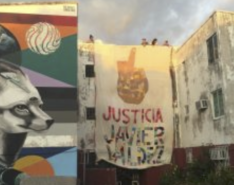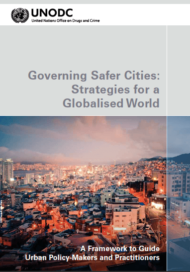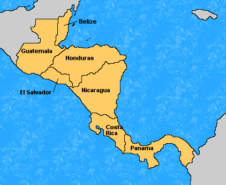Posted on 25 Oct 2013
A precarious gang truce brokered in 2011 in El Salvador has many crime experts wondering whether “talking to criminals” in other places could reduce criminal violence and help gangsters – and the communities who depend on them – find other ways to earn a living.
There is widespread recognition that the war on crime and drugs has largely failed to curtail drug cartels or stop criminal violence and drug abuse. Similarly, there is growing awareness about the extent to which criminal groups are embedded in the societies in which they operate. The result has been a call for a more creative and development-oriented approaches to combatting crime.
Robert Muggah, research director at the Igarapé Institute, sees a definite trend towards engaging with criminals in different ways: “We are starting to see some politicians and business leaders changing course. There are tentative examples of experimentation, with new approaches emerging across the Americas and, to a lesser extent, Africa and Asia, with interventions based on evidence rather than ideology.”
At a recent conference of the Global Initiative on Transnational Organized Crime, held in New York on 19 September, UN University head of office James Cockayne spoke about situations where working with criminals could pay off. In some fragile states and communities, criminal groups often have more legitimacy than state authorities, since they are often better able to deliver goods and services to people, he argued.
“We need to recognize that some criminal groups may be sources of social capital which could strengthen the state,” he said, but added that it would be naïve not to be aware of the inherent moral dilemmas and risks involved, such as negating victims’ rights or inadvertently strengthening the hand of the criminals themselves.
He cited the Haiti-based initiative run by NGO Viva Rio as a positive example. The initiative has seen former gangs take part “in innovative waste water recycling and distribution projects, which have helped improve community access to water and energy, while also encouraging gang members away from violence, creating alternative livelihoods, and building social capital between gangs, the community and the state”, he wrote in a paper that was presented at the conference.
Other examples of alternative approaches include gang truces Belize, Honduras and Guatemala; “pacification projects” in the slums of Rio de Janeiro; and “violence interruption” projects in the US. Initiatives like those in Rio involve new policing strategies, while others, like the Haiti initiative and offshoots of the El Salvador programme, have strong civil society components that attempt to rehabilitate criminals and offer them alternative jobs and social identities.
A risky approach
Attempting to work with – rather than lock away – criminals is not a new strategy: Burmese authorities have co-operated with local militias involved in drug trafficking since the 1960s, and in New York, examples of police cooperating with gangs go back to the 19th century. But now, against the backdrop of the failed war on drugs, global policy analysts are looking with renewed interest at such approaches and calling for more research.
Cockayne said the gang truces offered “important insights” but stressed the need for “scaling up comparative research”. Muggah said the many programmes that try to offer youth alternatives to crime show promising results but that the scientific evidence is still thin.
Speaking at the Global Initiative conference, Sarah Cliffe, Special Adviser and Assistant Secretary-General of Civilian Capacities, said working with former or current gang leaders and harnessing their knowledge has proved successful in some instances, but added: “The question is whether you strengthen their links by working with them.”
Therein lies the crux of the debate. Many of the policy’s detractors balk at the notion of negotiating with criminals, lest they emerge stronger. At the same conference, Rodrigo Avil, a government adviser in El Salvador, said that although the gang truce brokered between the Barrio 18 and Mara Salvatrucha gangs had reduced homicides by 40 percent, extortion and other gang-related activities had increased. “The gangs actually evolved and took advantage of the situation,” he said.
A similar, but less well known, gang truce in Belize, also introduced in 2011, saw the introduction of a programme funded by the US and UK to mediate disputes between gangs and offer job creation and education alternatives. But the costly programme not only ran out of money – according to some observers, it actually strengthened the gangs by effectively paying them to stay away from crime.
Whether the El Salvador truce has succeeded at all is the subject of fierce debate. Nevertheless, truces based on the El Salvador model are being explored in Guatemala, Honduras and Guadalajara, Mexico.
Muggah says that while truces and interventions can improve safety, they come with “political and potential social and economic costs”. “Where governments are seen to be making compromises, they may take a credibility hit with the electorate. Bilateral and multilateral partners may become more wary of being associated with them.
“And if problems emerge in the wake of negotiations, as they inevitably will, elected or appointed officials will be blamed. What is more, there are signs that if criminal groups are not effectively disbanded, they can re-assert control, extend their influence, and expand their rents [profits from illicit crime] in communities.”
Creating incentives
Some media accounts say the secret arrangement in El Salvador – made among imprisoned leaders from the two gangs and government officials who agreed to improve their prison conditions if the members outside stopped killing each other – is unravelling. Part of the problem is that the government has failed to publicly own up to its negotiation with the gangsters because of the potential political fall-out that could come from moral outrage over their having sat down with criminals.
This response is hardly surprising, given the “pain and suffering” the gang wars have caused, says Isabel Aguilar, coordinator of Interpeace’s Central American Youth Programme, which has been working closely with initiatives involving the rival gangs. But the lack of transparency allows conspiracy theories to prevail, including the allegation that the truce has opened the way for global drug trafficking networks to better control the territory.
Because the government is not a homogenous entity, different actors have vested interests in maintaining or sabotaging the truce, said Aguilar. Violence is also more profitable than peace for some players, including the private security industry that thrives in El Salvador. But, despite the problems, she remains upbeat. “I think it’s working, especially because the leadership of the gangs has the will to keep [the peace].”
Where prison conditions are so bad that an apple can cost US$75, it is easy to see why the 10,000 gangsters inside want better conditions. But what are the incentives for the estimated 50,000 gang members outside? Alternative means of employment and social networks replacing those offered by gangs will be essential to keeping them away from violence.
Aguilar says that the second phase of the truce – a grassroots violence prevention initiatives underway in 11 of the country’s 200 municipalities – although costly and tough to sustain, are slowly starting to bear fruit. After 17 years of fighting each other, they are exhausted, she said. “They are realizing that what they’re building hasn’t brought peace or the possibility of establishing normal lives and being happy.”
Mediators have made them aware that security and arms companies are the ones profiting from the violence. “Violence free” zones, established with the help of the Catholic Church, civil society and all political parties, have seen gangsters involved in clean-ups and building and education initiatives. Job creation programmes, funded by the government and the private sector, are offering gang members alternative ways to earn a living.
“We can say this is helping the process take root on the ground and be sustainable,” Aguilar said.
Changing the conversation
Meanwhile, pacification projects in the ‘favelas’, or shantytowns, of Rio de Janeiro have involved specially trained, heavily armed police giving gangs advance warning before moving in and taking control. The aim has been to bring down homicides and create new social norms, whereby brandishing weapons, engaging in gunfights and dealing drugs in public are no longer tolerated.
Desmond Arias, associate professor of the School of Public Policy at George Mason University, who has researched these pacification initiatives, says they do not exactly constitute “dialogue” with the criminals, but they are nevertheless a form of communication. “It is changing the conversation with the criminals, but it is still a one-sided conversation,” he said.
While the pacification projects are having some positive results – a drop in homicides, for example – the question is how sustainable the approach will be beyond the 2014 World Cup and 2016 Olympic Games, which are set to take place in Rio and have been driving the government’s efforts.
“There are lots of positive things about having police instead of armed gangs on street corners, but the question is: what are you building? How sustainable is this?” In those areas where civil society is strong, successes have been greater, he said, because local organizations are empowered to take ownership of their communities. He cites, for example, community-based programmes that help keep youth off the streets. “We need civil society to keep pressure up for these norms to stay once the government has lost interest,” he says, adding that police-driven initiatives tend to “wear themselves out”.
Just as negotiating peace with political adversaries is complex, so is negotiating peace with criminals. The interests of the criminal elites may not correspond to those of the rank and file. Graeme Simpson, director of Interpeace USA, said: “I worry about it. Forging agreements with gang leaders may be helping to suspend violence and decrease homicides, but what is being put in place for the criminals at street-level? We have to recognize the extent to which the criminal networks ‘hold them’. We have to replace these networks with other means of social and economic cohesion.”
To do this effectively and understand what compels criminals into illicit activity, “we need to listen to them rather than talk to them”, he said.
Originally published on IRIN, 25 October, 2013



